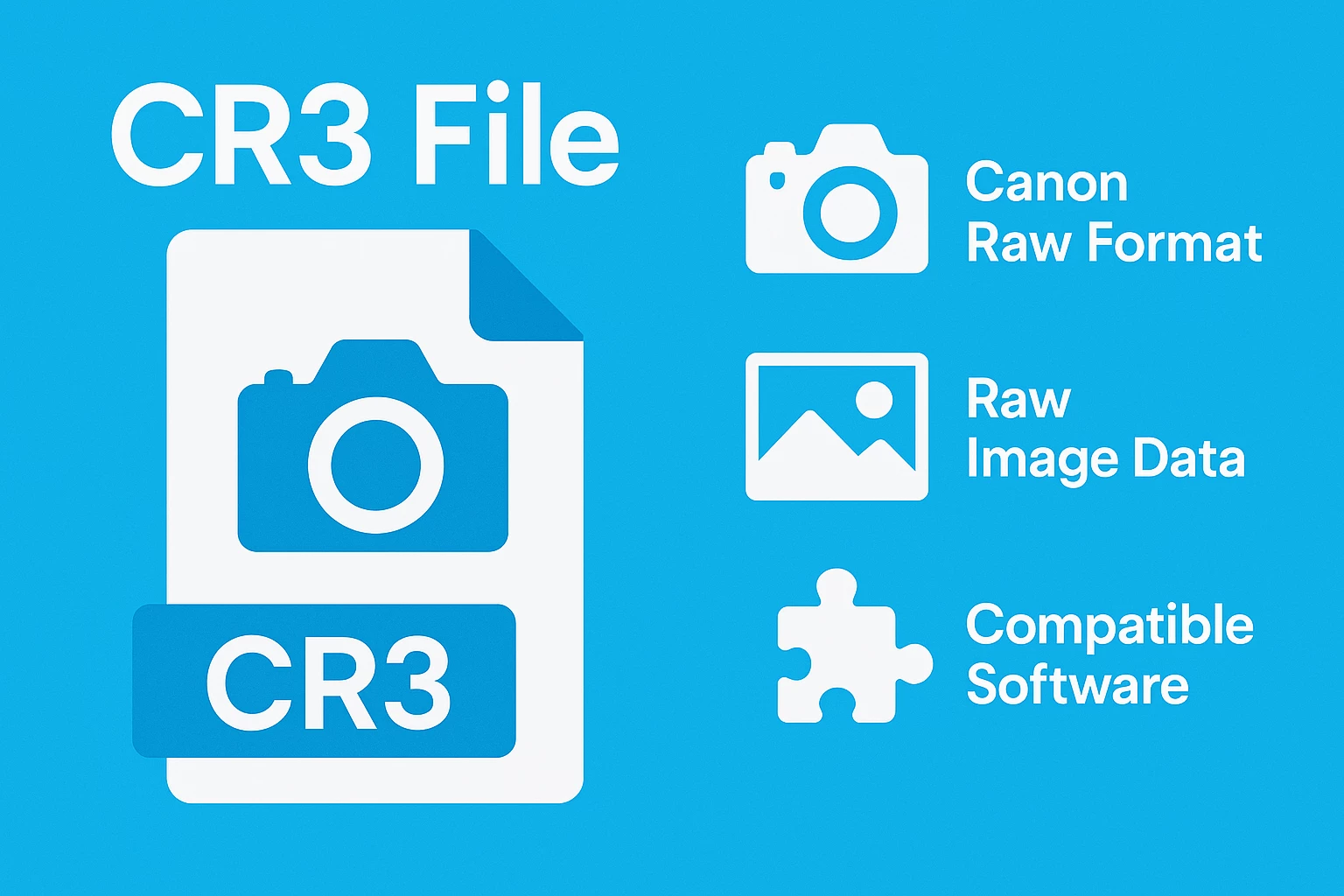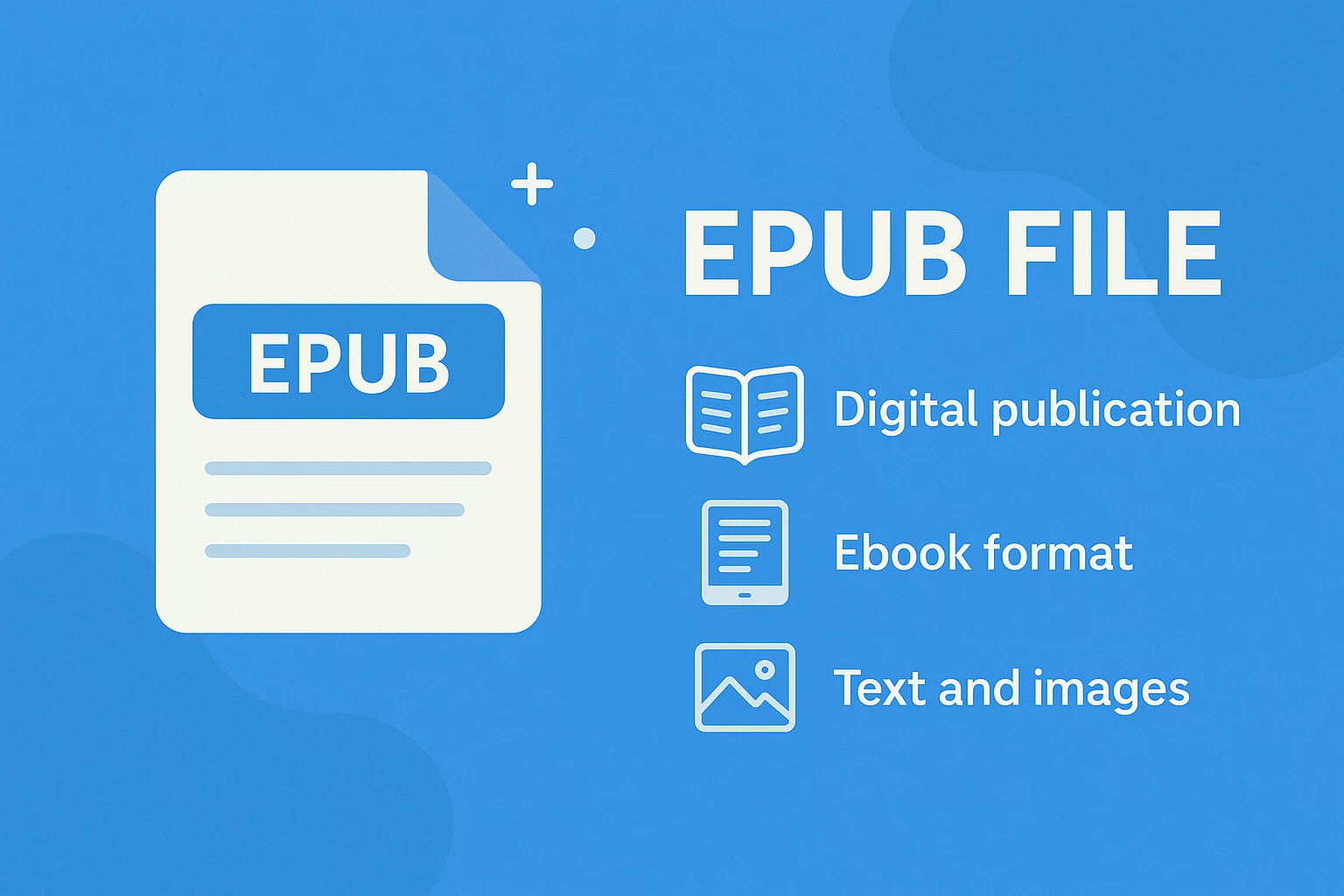
EPUB Files - What They Are & How to Open Them
EPUB has quietly become the foundation of digital reading. Almost every modern e-reader, tablet, and publishing platform relies on it because it’s light, flexible, and easy to scale across devices. I’ve worked with many digital formats over the years, and EPUB stands out for how well it balances structure and accessibility.
At its core, EPUB is an open, standardized format that allows ebooks to adapt to any screen size without losing layout or readability. It supports text, images, audio, and interactive elements, which makes it useful not only for novels but also for academic and technical content.
What I appreciate most about EPUB is its versatility, as it can look simple on a Kindle yet fully dynamic on a tablet or smartphone. In my guide, I’ll explain how EPUB works, what sets it apart from other ebook formats, and how to open, convert, and manage EPUB files with ease.

The Evolution of the EPUB Format#
EPUB has grown significantly since its introduction in the early 2000s. It was created by the International Digital Publishing Forum (IDPF) as a replacement for the older Open eBook format, which lacked flexibility and consistency.
Eventually, the main goal was to establish a single, open standard capable of adapting to any screen size while preserving structure, readability, and accessibility.
The first major release, EPUB 2.0, quickly became popular because it supported reflowable text, allowing ebooks to adjust naturally across different devices. Later versions introduced more advanced features such as multimedia support, interactive elements, and enhanced typography.
Then, the arrival of EPUB 3 marked a turning point by adding audio, video, JavaScript, and improved language compatibility, making it ideal for educational and interactive publications.
When the IDPF merged with the World Wide Web Consortium (W3C) in 2017, EPUB became part of the broader web ecosystem. The integration helped align the format with modern web standards like HTML and CSS, strengthening its compatibility and longevity.
Today, EPUB stands as the most trusted and widely supported format in digital publishing, recognized for its adaptability and long-term reliability.
Also read: What Is an MP4: Everything You Need to Know
How EPUB Files Work#
EPUB functions as a structured digital container that organizes text, images, and media into a single readable file. Each EPUB is essentially a compressed folder built on standard web technologies such as HTML, CSS, and XML, which define how the content appears and behaves across devices.
Every EPUB includes core components: a manifest that lists the file’s contents, a spine that defines reading order, and a collection of metadata that describes the ebook itself.
Because of this modular design, reading apps can easily interpret layout instructions, fonts, and navigation details to deliver a consistent reading experience.
Convert EPUB to Other Formats with MConverter
How Devices Interpret EPUB#
When an EPUB file is opened, the reading device or app extracts the internal web files and renders them as digital pages. The content automatically adjusts to the screen size, font settings, and orientation of the device.
Consequently, the reflowable structure ensures the text remains readable whether on a smartphone, tablet, or e-reader.
Modern EPUB readers also support advanced styling and interactive features. For example, educational books may include embedded videos, hyperlinks, or quizzes, all handled seamlessly through the device’s rendering engine.
The overall reading experience depends on how well the app supports EPUB 3 standards, as newer versions can display audio narration, animations, and complex layouts.
Related article: What Is a Zip File? Everything You Must Know
Inside the EPUB Metadata#
Metadata defines key information about an ebook: its title, author, publisher, publication date, and language. It also includes identifiers such as ISBN and subject tags that help organize and categorize the book across libraries or stores.
EPUB metadata is written in XML, which allows consistent interpretation by all ebook platforms. It helps search engines, library systems, and e-readers recognize important details instantly. Some metadata also controls navigation, such as table of contents links or chapter markers.
Simply, a well-structured EPUB file always includes clean and accurate metadata. It improves discoverability, ensures proper formatting across platforms, and gives readers the most professional experience possible.
Related article: What Is an ISO File? The Ultimate Guide for 2025
EPUB vs Other Ebook Formats#
EPUB remains the most flexible and widely supported ebook format. It was built around openness and accessibility, which is why it outperforms many proprietary or print-based alternatives.
Surely, I’ve worked with PDFs, MOBI files, and HTML-based ebooks, and EPUB always proves to be the most adaptable option for both reading and publishing. It maintains a consistent structure across devices and allows more freedom for customization without breaking layout or design.
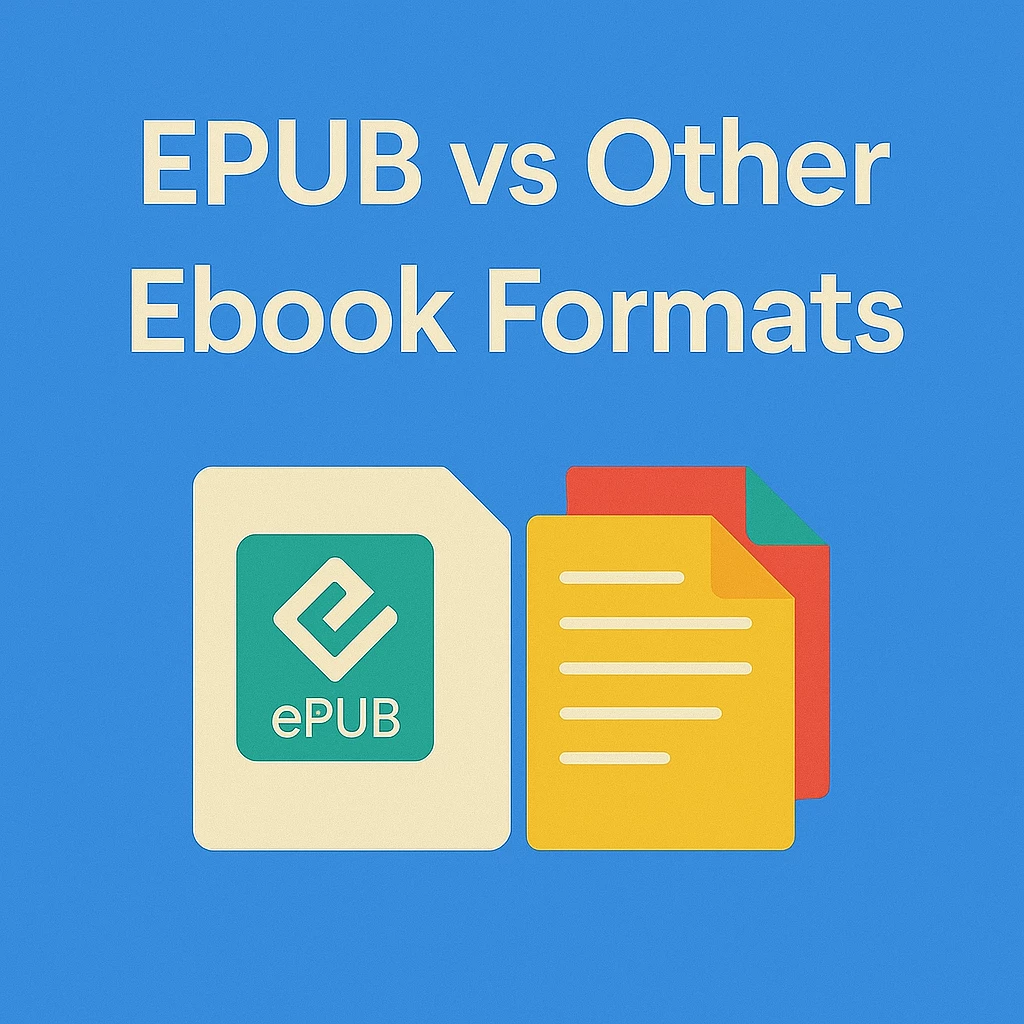
EPUB vs PDF#
PDF was created for print, so it keeps every page fixed in place. That’s perfect for preserving design accuracy, but difficult for comfortable reading on smaller screens. EPUB, in contrast, uses a reflowable layout, meaning text and images adjust naturally to any display.
I prefer PDF for design-heavy materials such as catalogs or brochures, while EPUB is better suited for novels, guides, and academic material that benefit from fluid readability.
Another major difference is accessibility. EPUB supports screen readers, scalable fonts, and adjustable contrast modes, making it more inclusive for readers with visual impairments. PDF often struggles to match that level of flexibility.
EPUB vs MOBI/AZW3 (Amazon Kindle)#
Amazon’s MOBI and AZW3 formats are designed exclusively for the Kindle ecosystem. They work well within Amazon’s platform but are difficult to use elsewhere. EPUB, being an open standard, works on nearly every other device and reading app, including Apple Books, Kobo, and Google Play Books.
For independent authors or publishers who want to reach the widest audience, EPUB offers a far better balance of control and accessibility.
Kindle users can still read EPUB files by converting them to a Kindle-compatible format, but the process adds extra steps. EPUB eliminates that friction across non-Amazon platforms, which is one reason it remains the preferred choice for open publishing.
Related article: What Is an Ogg File? Audio Format Explained
EPUB vs HTML & Web Books#
EPUB and HTML share the same foundation, relying on standard web technologies like HTML, CSS, and XML. The difference lies in delivery and structure. HTML web books exist online, relying on a live connection, while EPUB packages everything into a single file for offline reading.
I often describe EPUB as a portable website. It combines all the benefits of web design: responsive layout, hyperlinks, and multimedia, while keeping everything stored in one place.
So, it becomes ideal for readers who want a consistent, organized experience without needing internet access. To authors, it offers control over presentation while maintaining compatibility across devices.
Advantages of Using EPUB Format#
EPUB has earned its popularity because it brings together flexibility, accessibility, and open compatibility in a single format. I use it for most digital publishing projects since it performs well across devices without losing clarity or structure.
One of the biggest advantages is adaptability. EPUB automatically adjusts to any screen size or orientation, making reading comfortable on e-readers, tablets, phones, and computers. The reflowable layout keeps the text clean and easy to read, unlike fixed formats that distort on smaller screens.
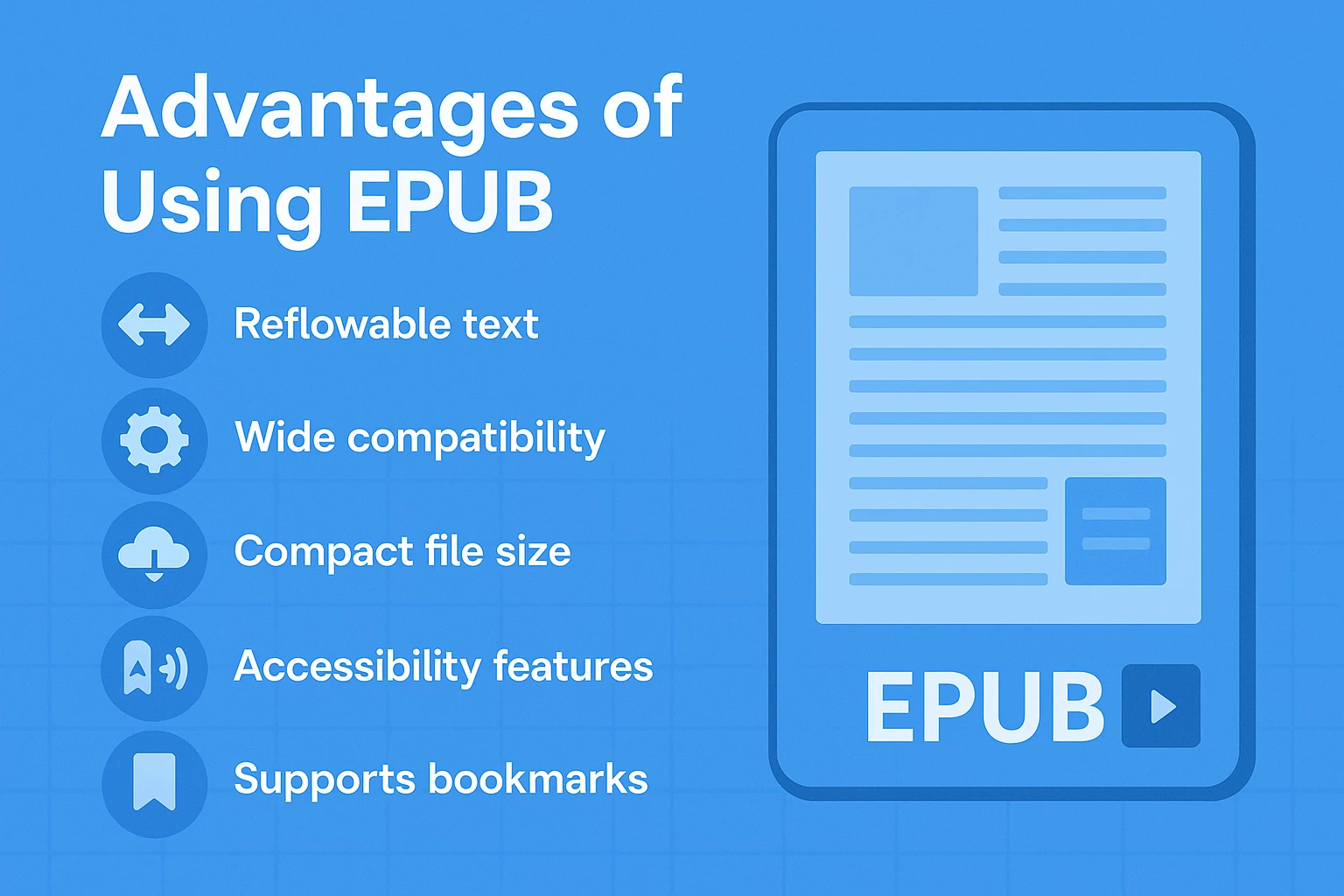
EPUB also supports interactive and multimedia elements, including images, hyperlinks, audio, and video. That makes it ideal for educational materials, illustrated books, or content that needs more than plain text. Publishers can embed rich features without compromising performance.
Another key benefit is accessibility. EPUB integrates well with screen readers, font scaling, and other accessibility tools. It allows customization for users with visual or cognitive challenges, giving everyone a consistent reading experience.
Finally, EPUB’s open standard means no platform restrictions or licensing barriers. It’s supported by most major e-readers and apps, which simplifies distribution and long-term preservation.
Similarly, authors, publishers, and educators can benefit from a format that’s easy to create, flexible to manage, and built to last.
Related article: What Is a HEIC File? A-to-Z Guide for Beginners
Disadvantages and Common Challenges#
Although EPUB is versatile and widely supported, it still presents a few limitations that can complicate publishing or reading workflows. I’ve encountered some of these challenges firsthand, especially when working across different devices or older systems.
One of the main drawbacks is inconsistent rendering. Not every e-reader or app interprets EPUB files the same way. A book that looks perfect in Apple Books might appear slightly off in Kobo or Google Play Books.
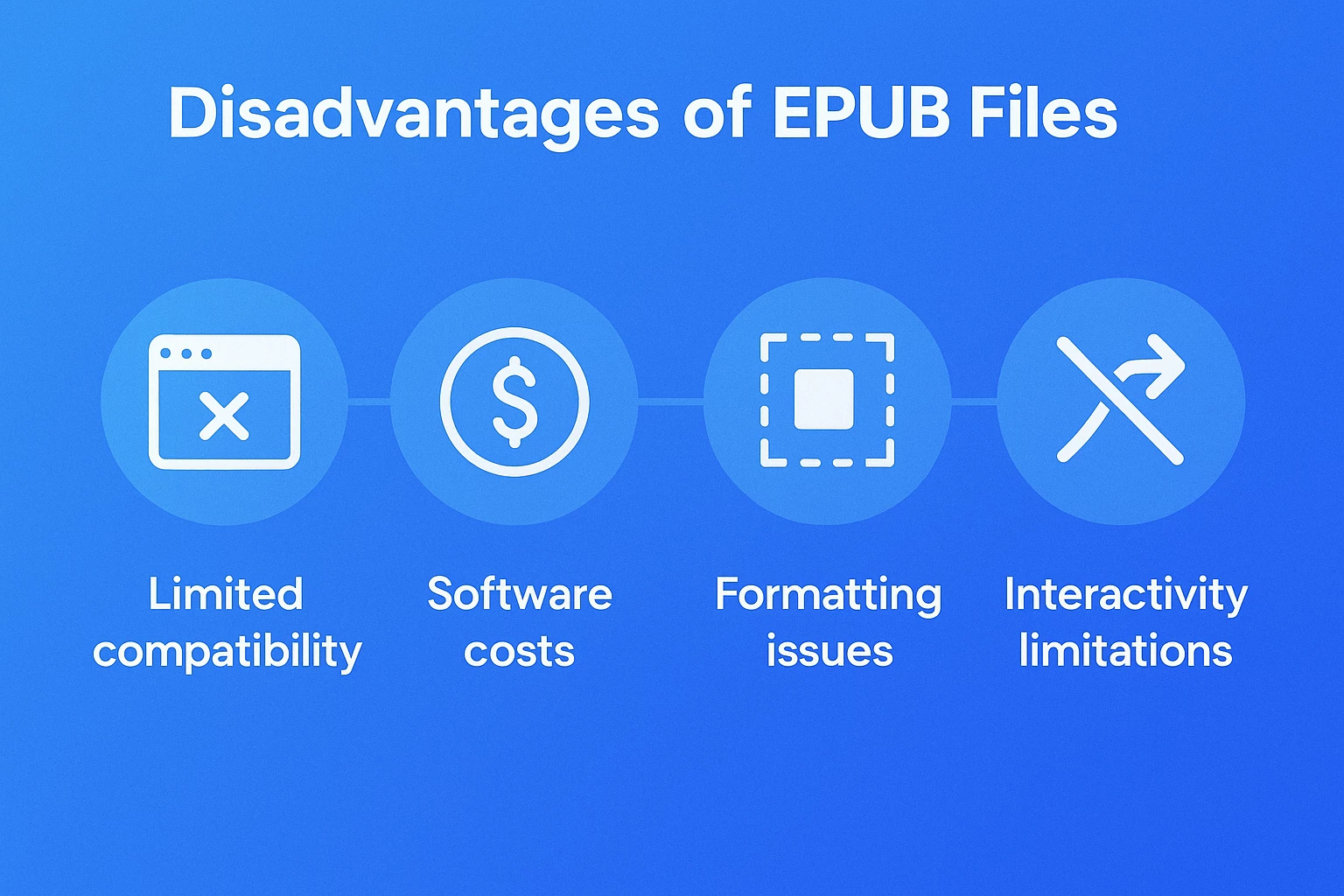
Additionally, fonts, spacing, and embedded elements can shift depending on how each app processes the layout. Publishers caring about precise formatting can get frustrated, though.
Another common issue is limited support for complex design. EPUB excels with reflowable text, but it struggles with intricate page layouts, multi-column designs, or heavily illustrated works. For visually rich publications, PDF or fixed-layout EPUBs often perform better, though they lose some flexibility.
File management can also be tricky. EPUBs that contain many images or multimedia files can grow large, slowing down performance on older devices. Some apps even reject oversized files altogether.
Finally, DRM protection can create problems. Many ebook stores apply digital rights management to EPUB files to prevent piracy, but that also restricts legitimate users from transferring or backing up their books freely.
Despite these challenges, EPUB remains the most reliable format for digital publishing. With careful formatting and proper testing across readers, most of these issues can be minimized or avoided entirely.
How to Create an EPUB File#
When I first tried turning my writing into an eBook, I assumed it would be complicated and time-consuming. But once I learned the basics, I realized it’s actually a simple process built on structure and the right tools.
If you want your book to look professional and read smoothly on any device, creating an EPUB file is the best place to start.
Using Word Processors and Export Tools#
I usually start by writing in Word or Google Docs because they’re simple to use and great for structuring text. I make sure my headings are consistent, chapters are clearly divided, and spacing is clean. Once everything looks good, I use the Export as EPUB feature, which most modern word processors now include.
If the program I’m using doesn’t have that option, our software simply creates the EPUB file. It’s fast, easy, and keeps all my formatting exactly how I want it.
Using Dedicated EPUB Editors#
When I need more creative control, I move to tools like Sigil, Atticus, or Adobe InDesign. They allow me to customize fonts, layouts, and covers while ensuring that the final product feels polished and professional. I use these tools when preparing eBooks for publishing platforms or clients that expect precise formatting.
Anyway, the learning curve can be a bit steep at first, but once you get used to the interface, the results speak for themselves.
Validating EPUB Files#
Before sharing or publishing, I always validate my EPUB file using EPUBCheck. It helps catch small issues such as broken links or missing metadata that could affect how the file opens on different devices.
When I see that “validation passed” confirmation, it feels like the final seal of approval, knowing the eBook is ready to share confidently with readers.
How to Open and Read EPUB Files#
If you’ve downloaded an EPUB and aren’t sure where to start, you’re not alone. The format works across most devices, and setting it up only takes a minute. Let’s see how you can open and read your EPUB files on desktop, mobile, or even your Kindle.
On Desktop#
I usually open EPUB files on my computer using tools like Calibre, Apple Books (on Mac), or SumatraPDF (on Windows). They make navigation easy, let me adjust font size, and even bookmark my progress. If I’m working on edits, Calibre is especially helpful since it lets me view and tweak the layout.
You can also read EPUB files in your browser by using extensions like EPUBReader for Chrome or Firefox, which is perfect if you don’t want to install extra software.
On Mobile#
Reading EPUBs on my phone or tablet is incredibly convenient. I like using apps such as Apple Books, Google Play Books, or PocketBook Reader. Once I upload the file, the app automatically syncs my progress so I can pick up right where I left off.
Most mobile readers also allow night mode and font customization, which makes long reading sessions much easier on the eyes.
On Kindle Devices#
Kindle devices don’t natively support EPUB files, but there’s an easy workaround. I usually convert the EPUB to MOBI or AZW3 format using MConverter and then send it to my Kindle via email or the Send to Kindle app.
Once the conversion is done, the book appears in my Kindle library just like any other title. It takes only a few minutes and makes reading EPUB books on Kindle smooth and seamless.
Related article: What Is a Mov File? Pros, Cons, and How to Use It
How to Convert EPUB to Other Formats#
If you ever find that your EPUB file isn’t opening on a device or you want to share it with someone who uses a different format, converting it is the most convenient solution. Some platforms and readers still rely on PDF, MOBI, or DOCX, so having a reliable way to change formats makes it easier to access and share your content anywhere.
Using MConverter, you can upload your EPUB file and select from a variety of output formats in just a few clicks. The process is smooth, fast, and entirely browser-based, so there’s no need to download any extra software.
Once converted, your file is ready to open, print, or share instantly.
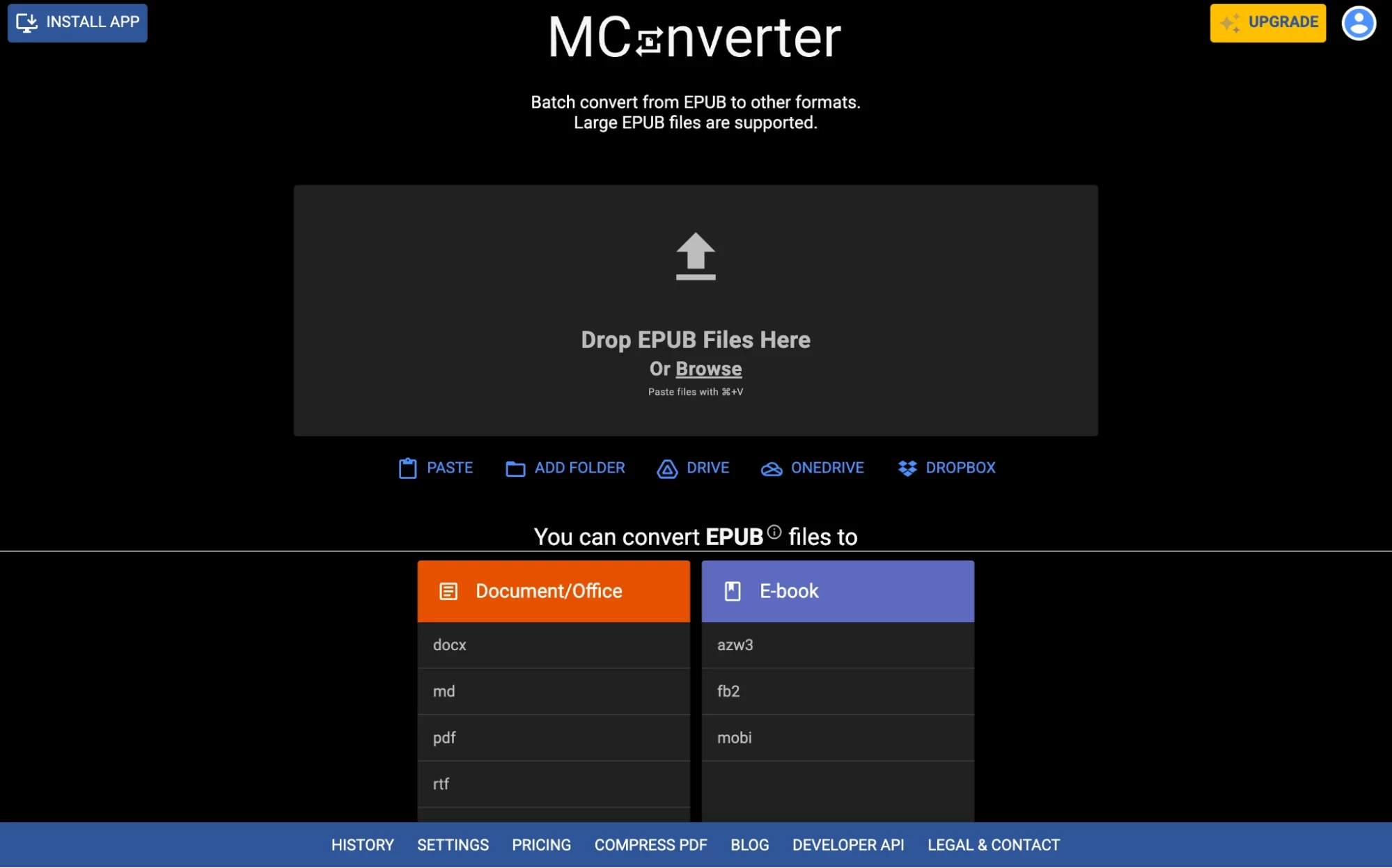
My favorite thing about MConverter is that it supports bulk uploads, preserves your document’s original formatting, and works securely across all devices.
Whether you’re preparing files for Kindle, sharing reading material with colleagues, or simply keeping your library organized, it’s a quick and practical way to make your EPUB files more flexible.
The Role of EPUB in the AI and Web 3.0 Era#
The EPUB format has grown into much more than a simple container for eBooks. In the age of AI and Web 3.0, it’s becoming part of a smarter and more interactive digital world. With AI-powered tools, EPUB files can now adapt to each reader’s preferences, adjusting tone, layout, and even suggesting related materials based on reading behavior.
Naturally, EPUB offers a new level of flexibility for publishers and creators. AI makes it easier to automate formatting, translation, and personalized content recommendations while keeping accessibility consistent across all devices.
As Web 3.0 emphasizes decentralization and user control, EPUB supports content ownership, privacy, and seamless interoperability.
The future of digital publishing is shifting toward adaptive and intelligent reading experiences, and EPUB continues to play a vital role in shaping how that evolution unfolds.
Common Mistakes to Avoid When Creating EPUB Files#
Creating an EPUB file might seem simple, but a few overlooked details can cause major display or compatibility issues. One of the most common mistakes is not validating your file before publishing. Even small coding errors or missing metadata can make your EPUB unreadable on certain devices.
Another frequent issue is poor image optimization. Using large or uncompressed images can slow down loading times and make your file unnecessarily heavy. Keeping images properly sized and compressed ensures a smooth reading experience.
Many creators also forget about consistent styling and structure. Inconsistent font choices, heading formats, or navigation links can make an EPUB look unprofessional and difficult to follow.
Finally, never skip testing on multiple devices and apps. An EPUB that looks perfect on one eReader might appear broken on another. Checking your file across different platforms helps guarantee a professional and user-friendly result.
Security and File Integrity#
EPUB files are generally safe to use, but keeping them secure and intact requires some awareness. Always download or share EPUBs from reliable sources, as unverified files may include corrupted data or hidden code that disrupts readability.
When converting or editing EPUBs, use trusted software that protects your data and maintains the structure of the file. Avoid online tools that lack transparency about how your files are stored or shared.
It’s also smart to verify file authenticity. Checking digital signatures or comparing file hashes ensures that the EPUB hasn’t been modified without permission. Consistently backing up your files and using reliable tools helps preserve both content quality and data integrity over time.
Related article: What Is JPEG: The Most Popular Image Format Explained
EPUB for Publishers and Authors#
For publishers and authors, the EPUB format has become a cornerstone of modern digital publishing. It offers flexibility, accessibility, and compatibility across nearly all reading platforms, making it the preferred choice for distributing eBooks and digital publications.
Authors appreciate EPUB for its ability to preserve creative control. The format supports rich media, dynamic layouts, and interactive elements while maintaining a consistent reading experience across devices. It also allows easy updates and edits without needing to reformat an entire book.
Publishers benefit from its scalability. An EPUB file can be distributed globally with minimal cost, reaching readers through major retailers, libraries, and subscription platforms. Adopting EPUB as a standard, authors and publishers can focus more on storytelling and content quality rather than technical limitations.
Closing Words#
EPUB has transformed the way digital content is created, distributed, and experienced. It’s not just another file type but a true connection between creativity and accessibility.
No matter if you’re an author releasing your first book, a publisher handling an entire catalog, or a reader who values a seamless experience, EPUB delivers the flexibility and reliability you need.
As technology continues to advance, EPUB remains one of the most reliable and adaptable formats for digital reading. If you haven’t worked with EPUB yet, now is a great time to explore its flexibility, no matter you’re creating, converting, or simply enjoying your favorite books.
About the author
Mihael joined MConverter as a co-founder in 2023, bringing a vision to transform a tech tool into a product company built around meaningful user experience. With roots in B2B sales, product development, and marketing, he thrives on connecting the dots between business strategy and customer needs. At MConverter, he shapes the bigger picture - building the brand, inspiring teams, and pushing innovation forward with a can-do mindset. For Mihael, it’s not just about file conversions, but about creating experiences that deliver real impact.
Check out more articles
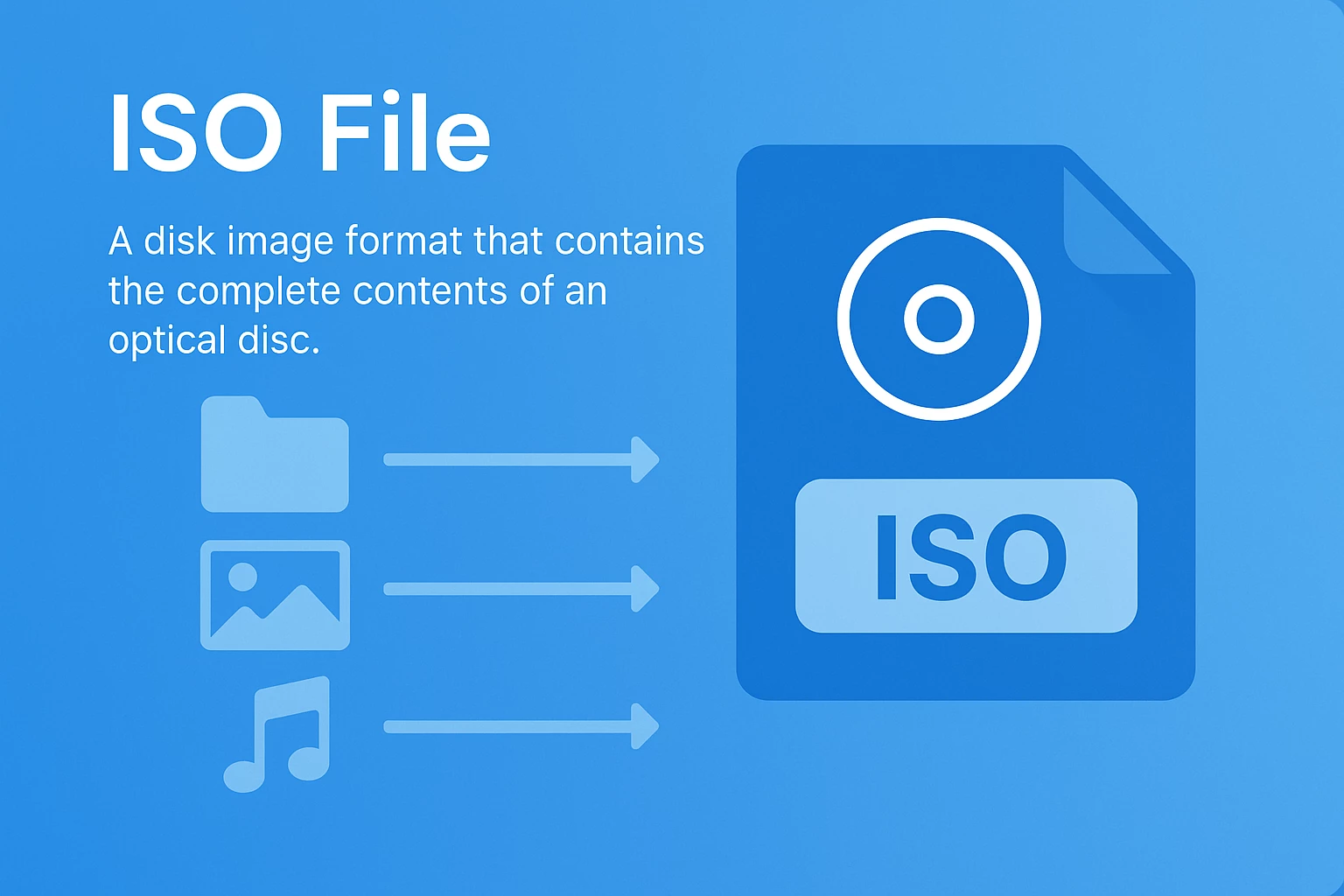
What Is an ISO File? The Ultimate Guide for 2025
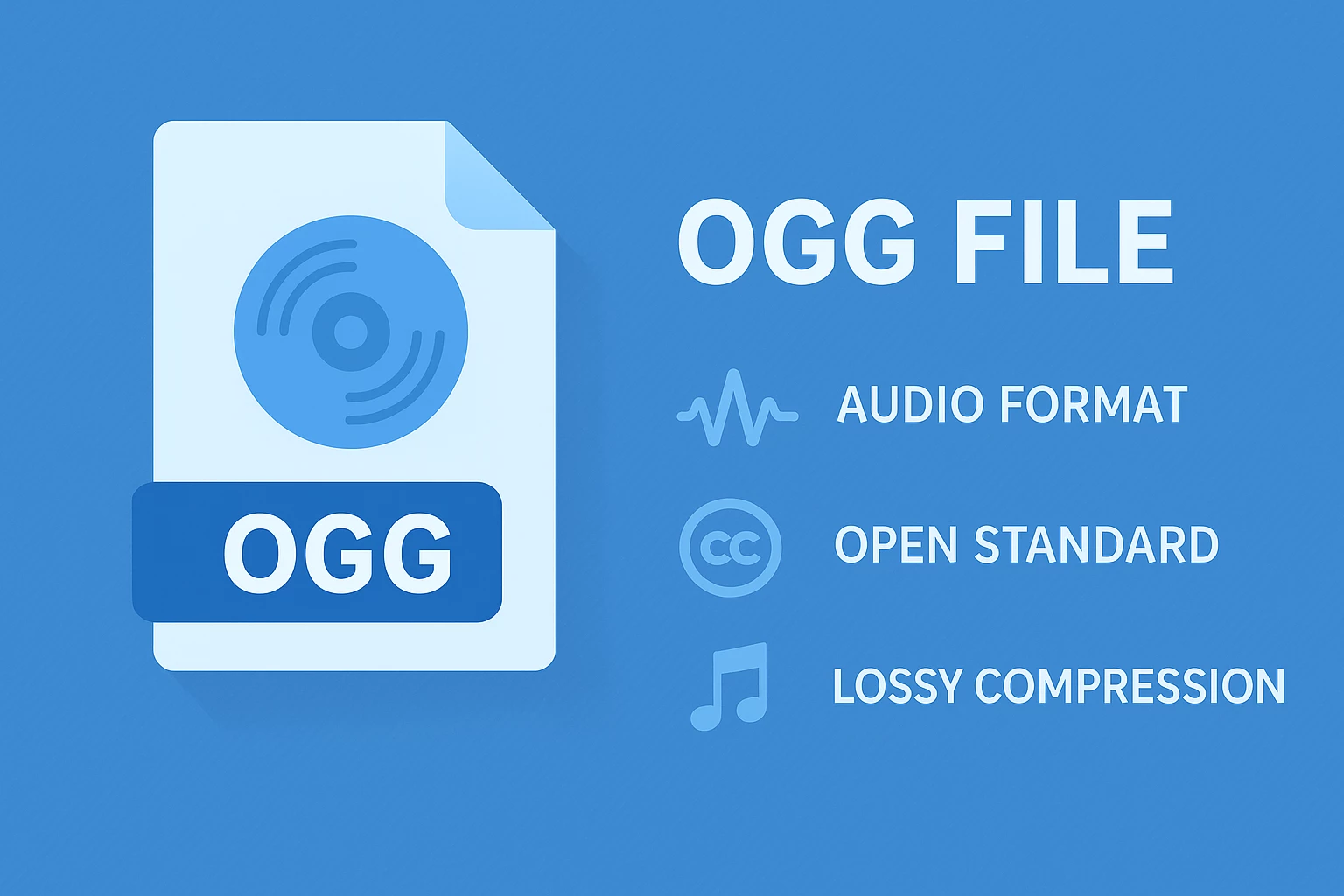
What Is an OGG File? Audio Format Explained
